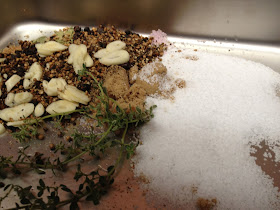I’ve put up a couple posts on makin’ bacon and now I want to take a moment out of our normally scheduled programming to talk about bacon’s lesser known but equally (if not more) flavorful cousin, Father Guido Pancetta (FGP for short). As far as meat is concerned it’s the same cut as bacon, pork belly and in this case I used a nice half Duroc belly from our friends over at Salmon Creek Farms. Similar to bacon this belly was also cured but instead of the basic cure I used with my bacon (The Baconing Part I) brown sugar is substituted for the white sugar and the ratio is adjusted. At this point we’re taking the proverbial left turn at Albuquerque and it’s the last time you’ll see much resemblance between bacon and pancetta (aka FGP).
I adapted this recipe from Polcyn and Ruhlman’s book,Charcuterie, which is a great resource to start your journey into charcuterie.
Father Guido Pancetta
2.25 kilogram pork belly (skinless) - my belly was closer to 2.07 kg
2.25 kilogram pork belly (skinless) - my belly was closer to 2.07 kg
4 garlic cloves, thinly sliced
12 g pink salt (available from Butcher & Packer)
50 g light brown sugar
40 g black peppercorns (divided use)
20 g coriander seeds
10 g juniper berries
4 bay leaves, crumbled
4 g freshly grated nutmeg
4 sprigs fresh thyme (I left mine mostly whole)
Rinse the belly and pat dry. Keep the belly refrigerated until ready to use. In a small pan toast the juniper berries, coriander seeds and half the peppercorns for a couple minutes, this will help make everything more flavorful.
Mix your ground spices with everything else and combine well.
Get your belly out of the refrigerator and rub your salt/spice mix all over the belly, use it all. Pretend you're Swedish and your massaging the belly, make it all happy happy and don’t forget the sides. Any excess cure mix can be sprinkled on the bottom of the dish you plan on curing the belly in and the rest on top. Start the belly with the skin side down as the cure mix has a difficult time moving through the fat.
Cover your belly and toss it back in the fridge. Alternatively if you’re using a smaller piece of belly you can vacuum seal it or put it in a really large zip-top bag. I used a hotel pan covered with plastic wrap and foil.
it was rinsed well, and coated on the non-skin side with the reserved 20 g of peppercorns which were toasted and ground (a little finer than the cure mix because you're more likely to eat this pepper).
As this is a short term cured product with no additional preservation it should be cooked prior to consumption. One of the most common places you’ll see pancetta is in pasta carbonara (my version can be found here: Pasta Carbonara del Mar). You can also slice it like bacon and cook it up for an awesome BLFGPs (bacon, lettuce and Father Guido Pancetta sandwich). I also chopped a small piece into smaller pieces, sauteed it until crispy and topped some store-bought cheese raviolis with some pesto and the FGP and did a little happy dance....









No comments:
Post a Comment